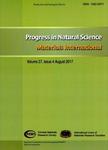Late Neogene radiolarian absence event in the southern South China Sea and its paleoceanographic implication
Late Neogene radiolarian absence event in the southern South China Sea and its paleoceanographic implication作者机构:Key Laboratory of Marginal Sea Geology South China Sea Institute of Oceanology Chinese Academy of Sciences Guangzhou 510301 China Graduate University of Chinese Academy of Sciences Beijing 100039 China
出 版 物:《Progress in Natural Science:Materials International》 (自然科学进展·国际材料(英文))
年 卷 期:2008年第18卷第3期
页 面:281-287页
核心收录:
学科分类:070903[理学-古生物学与地层学(含:古人类学)] 0709[理学-地质学] 07[理学] 0805[工学-材料科学与工程(可授工学、理学学位)] 0702[理学-物理学]
基 金:2007CB815905 National Natural Science Foundation of China,NSFC: 0476024,40631007 National Key Research and Development Program of China,NKRDPC: 2006BAB19B03
主 题:Southern South China Sea Late Neogene Radiolarian absence event
摘 要:Down-core variations of radiolarians at ODP Site 1143 in the southern South China Sea (SCS) are presented for the last 12 Myr. The fluctuations of radiolarian abundances since the Late Miocene can be divided into three stages: a high abundance stage at 12-5.96 Myr, a radiolarian absent stage at 5.96-3.30 Myr and a gradual increasing stage after 3.30 Myr. The three stages correspond to the forming and vicissitudes of the Western Pacific Warm Pool (WPWP) and the Eastern Asian Summer Monsoon (EASM). The radiolarian absence event (RAE) was also absent of diatom and occurred nearly simultaneously with the closures of the Panama Isthmus and the Indonesian seaway, which probably caused the reorganization of oceanic circulation systems. Accompanied this circulation reorganization was the weakening of the WPWP and the EASM, which probably led to a weakened upwelling in the southern SCS. In addition dissolved silica (Dsi) content in surface seawater might be very low during 5.96-3.30 Myr due to the ’’biogenic bloom event, which consumed a large amount of Dsi in the surface seawater. All these factors together might lead to a great decrease of siliceous production in the southern SCS and consequently caused the RAE. Moreover, the dissolution of siliceous skeletons might also influence the abundance of radiolarians.



